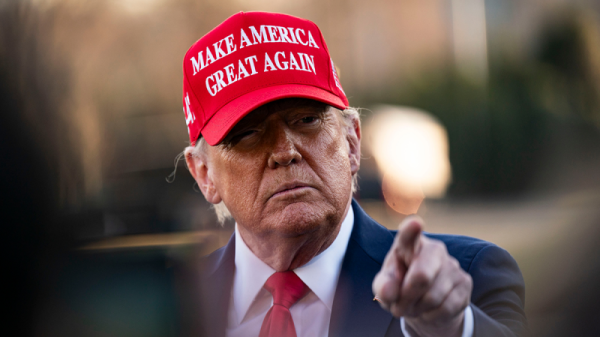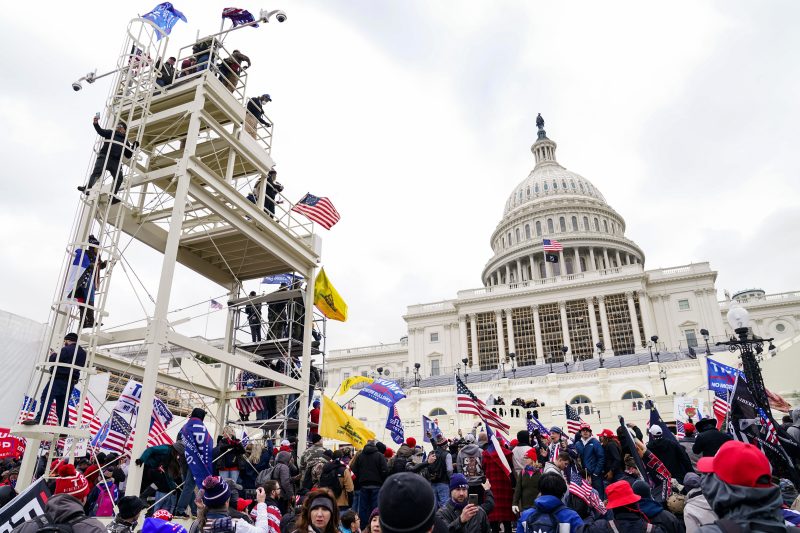Federal prosecutors improperly charged a Jan. 6 defendant with obstruction, the Supreme Court ruled on Friday, a decision that will likely upend many cases against rioters who disrupted the certification of the 2020 presidential election and one which Donald Trump’s legal team may use to try to whittle down one of his criminal cases.
After the Jan. 6, 2021, attack on the Capitol, federal prosecutors charged more than 350 participants among the pro-Trump mob with obstructing or impeding an official proceeding. The charge carries a 20-year maximum penalty and is part of a law enacted after the exposure of massive fraud and shredding of documents during the collapse of the energy giant Enron.
Writing for the majority, Chief Justice John G. Roberts Jr. said prosecutors’ overly broad reading of the statute gives them too much discretion to seek a 20-year maximum sentence “for acts Congress saw fit to punish only with far shorter terms of imprisonment.”
The decision sends the case of alleged rioter Joseph W. Fischer back to the lower courts for additional litigation in light of the majority’s finding that prosecutors must show a defendant impaired records, documents or other objects for use in an official proceeding. Other defendants charged with obstruction can also now seek to have that charge dismissed.
Two of the four charges Trump faces for allegedly conspiring to obstruct the 2020 election results are based on the obstruction statute at issue in the court’s decision. Special counsel Jack Smith, who brought the case against Trump, has said that even if the Supreme Court ruled the charge was improper for the rioters, it should still stand for the former president and presumptive Republican nominee, who is accused of different conduct.
Trump’s lawyers have filed a host of legal arguments seeking to get the case thrown out of court, and it remains to be seen if they will try to use the Fischer v. United States decision to further those efforts. A Trump spokesman did not immediately comment, but Trump posted “BIG WIN!” on social media shortly after the 6-3 decision was issued.
Attorney General Merrick Garland said he was disappointed with the ruling but insisted it was not a body blow to the overall investigation and prosecution of the riot at the U.S. Capitol.
“January 6 was an unprecedented attack on the cornerstone of our system of government — the peaceful transfer of power from one administration to the next,” Garland said in a written statement. “The vast majority of the more than 1,400 defendants charged for their illegal actions on January 6 will not be affected by this decision.” Garland noted that not a single Jan. 6 defendant was charged solely with the crime at issue in the Fischer case — though a small number faced no other felonies. “For the cases affected by today’s decision, the Department will take appropriate steps to comply with the Court’s ruling.”
Fischer’s lawyer, Jeffrey T. Green, said in a statement Friday that the “impact of the opinion on other prosecutions remains to be seen, but we are happy to have driven this criminal statute back to its proper evidence-tampering turf.”
More broadly, the Supreme Court’s decision will affect which tools prosecutors have to charge anyone who tries to disrupt a government proceeding through protest that turns violent. The ruling is consistent with a trend in recent years in which the high court has narrowed prosecutorial discretion in certain criminal cases because of concerns about over-criminalization.
#g-Fischer_v_US-box,
#g-Fischer_v_US-box .g-artboard {
margin:0 auto;
}
#g-Fischer_v_US-box p {
margin:0;
}
.g-aiAbs {
position:absolute;
}
.g-aiImg {
display:block;
width:100% !important;
}
.g-aiSymbol {
position: absolute;
box-sizing: border-box;
}
.g-aiPointText p { white-space: nowrap; }
#g-Fischer_v_US-xxsmall {
position:relative;
overflow:hidden;
}
#g-Fischer_v_US-xxsmall p {
font-family:Franklin,FranklinITCStdLight,Helvetica,Arial,sans-serif !important;
font-weight:400 !important;
font-size:11px !important;
line-height:14px !important;
height:auto !important;
filter:alpha(opacity=100) !important;
-ms-filter:progid:DXImageTransform.Microsoft.Alpha(Opacity=100) !important;
opacity:1 !important;
letter-spacing:0em !important;
text-align:left !important;
color:rgb(0,0,0) !important;
text-transform:none !important;
padding-bottom:0 !important;
padding-top:0 !important;
mix-blend-mode:normal !important;
font-style:normal !important;
position:static !important;
}
#g-Fischer_v_US-xxsmall .g-pstyle0 {
line-height:8px !important;
height:8px !important;
}
#g-Fischer_v_US-xxsmall .g-pstyle1 {
line-height:13px !important;
height:13px !important;
text-align:center !important;
}
#g-Fischer_v_US-xxsmall .g-pstyle2 {
height:14px !important;
text-align:center !important;
}
#g-Fischer_v_US-xxsmall .g-pstyle3 {
font-family:Franklin,Helvetica,Arial,sans-serif !important;
font-weight:700 !important;
height:14px !important;
text-align:center !important;
}
#g-Fischer_v_US-xsmall {
position:relative;
overflow:hidden;
}
#g-Fischer_v_US-xsmall p {
font-family:Franklin,FranklinITCStdLight,Helvetica,Arial,sans-serif !important;
font-weight:400 !important;
font-size:14px !important;
line-height:18px !important;
height:auto !important;
filter:alpha(opacity=100) !important;
-ms-filter:progid:DXImageTransform.Microsoft.Alpha(Opacity=100) !important;
opacity:1 !important;
letter-spacing:0em !important;
text-align:left !important;
color:rgb(0,0,0) !important;
text-transform:none !important;
padding-bottom:0 !important;
padding-top:0 !important;
mix-blend-mode:normal !important;
font-style:normal !important;
position:static !important;
}
#g-Fischer_v_US-xsmall .g-pstyle0 {
height:18px !important;
}
#g-Fischer_v_US-xsmall .g-pstyle1 {
line-height:11px !important;
height:11px !important;
}
#g-Fischer_v_US-xsmall .g-pstyle2 {
line-height:17px !important;
height:17px !important;
text-align:center !important;
}
#g-Fischer_v_US-xsmall .g-pstyle3 {
height:18px !important;
text-align:center !important;
}
#g-Fischer_v_US-xsmall .g-pstyle4 {
font-family:Franklin,Helvetica,Arial,sans-serif !important;
font-weight:700 !important;
height:18px !important;
text-align:center !important;
}
#g-Fischer_v_US-medium {
position:relative;
overflow:hidden;
}
#g-Fischer_v_US-medium p {
font-family:Franklin,FranklinITCStdLight,Helvetica,Arial,sans-serif !important;
font-weight:400 !important;
font-size:14px !important;
line-height:18px !important;
height:auto !important;
filter:alpha(opacity=100) !important;
-ms-filter:progid:DXImageTransform.Microsoft.Alpha(Opacity=100) !important;
opacity:1 !important;
letter-spacing:0em !important;
text-align:left !important;
color:rgb(0,0,0) !important;
text-transform:none !important;
padding-bottom:0 !important;
padding-top:0 !important;
mix-blend-mode:normal !important;
font-style:normal !important;
position:static !important;
}
#g-Fischer_v_US-medium .g-pstyle0 {
height:18px !important;
}
#g-Fischer_v_US-medium .g-pstyle1 {
font-size:15px !important;
line-height:17px !important;
height:17px !important;
text-align:center !important;
}
#g-Fischer_v_US-medium .g-pstyle2 {
height:18px !important;
text-align:center !important;
}
#g-Fischer_v_US-medium .g-pstyle3 {
font-family:Franklin,Helvetica,Arial,sans-serif !important;
font-weight:700 !important;
height:18px !important;
text-align:center !important;
}
#g-Fischer_v_US-xlarge {
position:relative;
overflow:hidden;
}
#g-Fischer_v_US-xlarge p {
font-family:Franklin,FranklinITCStdLight,Helvetica,Arial,sans-serif !important;
font-weight:400 !important;
font-size:16px !important;
line-height:18px !important;
height:auto !important;
filter:alpha(opacity=100) !important;
-ms-filter:progid:DXImageTransform.Microsoft.Alpha(Opacity=100) !important;
opacity:1 !important;
letter-spacing:0em !important;
text-align:left !important;
color:rgb(0,0,0) !important;
text-transform:none !important;
padding-bottom:0 !important;
padding-top:0 !important;
mix-blend-mode:normal !important;
font-style:normal !important;
position:static !important;
}
#g-Fischer_v_US-xlarge .g-pstyle0 {
height:18px !important;
}
#g-Fischer_v_US-xlarge .g-pstyle1 {
font-size:20px !important;
line-height:22px !important;
height:22px !important;
text-align:center !important;
}
#g-Fischer_v_US-xlarge .g-pstyle2 {
height:18px !important;
text-align:center !important;
}
#g-Fischer_v_US-xlarge .g-pstyle3 {
font-family:Franklin,Helvetica,Arial,sans-serif !important;
font-weight:700 !important;
height:18px !important;
text-align:center !important;
}
/* Custom CSS */
.g-textshadow-black p {
text-shadow: 0 1px 3px rgb(0 0 0 / 80%);
}
.g-textshadow-white p {
text-shadow: 0 1px 3px rgb(255 255 255 / 80%);
}
.g-textshadow-grey p {
text-shadow: 0 1px 3px rgb(192 192 192 / 80%);
}
.g-textoutline-white p {
text-shadow: -1px -1px 0 #fff, 1px -1px 0 #fff, -1px 1px 0 #fff, 1px 1px 0 #fff;
}
.g-textoutline-black p {
text-shadow: -1px -1px 0 #000, 1px -1px 0 #000, -1px 1px 0 #000, 1px 1px 0 #000;
}
.g-textoutline-grey p {
text-shadow: -1px -1px 0 #c0c0c0, 1px -1px 0 #c0c0c0, -1px 1px 0 #c0c0c0, 1px 1px 0 #c0c0c0;
}
Joined the majority
Dissented
Decision author
LIBERAL BLOC
CONSERVATIVE BLOC
Jackson
Roberts
Barrett
Alito
Kagan
Kavanaugh
Thomas
Gorsuch
Sotomayor
Decision author
Joined the majority
Dissented
LIBERAL BLOC
CONSERVATIVE BLOC
Jackson
Roberts
Barrett
Alito
Kagan
Kavanaugh
Thomas
Gorsuch
Sotomayor
Decision author
Joined the majority
Dissented
LIBERAL BLOC
CONSERVATIVE BLOC
Sotomayor
Jackson
Kagan
Roberts
Kavanaugh
Barrett
Gorsuch
Alito
Thomas
Joined the majority
Dissented
Decision author
LIBERAL BLOC
CONSERVATIVE BLOC
Sotomayor
Jackson
Kagan
Roberts
Kavanaugh
Barrett
Gorsuch
Alito
Thomas
(function (containerId, opts) {
if (!(‘querySelector’ in document)) return;
var container = document.getElementById(containerId);
var nameSpace = opts.namespace || ”;
var onResize = throttle(update, 200);
var waiting = !!window.IntersectionObserver;
var observer;
update();
document.addEventListener(‘DOMContentLoaded’, update);
window.addEventListener(‘resize’, onResize);
// NYT Scoop-specific code
if (opts.setup) {
opts.setup(container).on(‘cleanup’, cleanup);
}
function cleanup() {
document.removeEventListener(‘DOMContentLoaded’, update);
window.removeEventListener(‘resize’, onResize);
if (observer) observer.disconnect();
}
function update() {
var artboards = selectChildren(‘.’ + nameSpace + ‘artboard[data-min-width]’, container),
width = Math.round(container.getBoundingClientRect().width);
// Set artboard visibility based on container width
artboards.forEach(function(el) {
var minwidth = el.getAttribute(‘data-min-width’),
maxwidth = el.getAttribute(‘data-max-width’);
if (+minwidth = width || maxwidth === null)) {
if (!waiting) {
selectChildren(‘.’ + nameSpace + ‘aiImg’, el).forEach(updateImgSrc);
}
el.style.display = ‘block’;
} else {
el.style.display = ‘none’;
}
});
// Initialize lazy loading on first call
if (waiting && !observer) {
if (elementInView(container)) {
waiting = false;
update();
} else {
observer = new IntersectionObserver(onIntersectionChange, {});
observer.observe(container);
}
}
}
function elementInView(el) {
var bounds = el.getBoundingClientRect();
return bounds.top 0;
}
// Replace blank placeholder image with actual image
function updateImgSrc(img) {
var src = img.getAttribute(‘data-src’);
if (src && img.getAttribute(‘src’) != src) {
img.setAttribute(‘src’, src);
}
}
function onIntersectionChange(entries) {
if (entries.length && entries[0].isIntersecting) {
waiting = false;
observer.disconnect();
observer = null;
update();
}
}
function selectChildren(selector, parent) {
return parent ? Array.prototype.slice.call(parent.querySelectorAll(selector)) : [];
}
// based on underscore.js
function throttle(func, wait) {
var timeout = null, previous = 0;
function run() {
previous = Date.now();
timeout = null;
func();
}
return function() {
var remaining = wait – (Date.now() – previous);
if (remaining wait) {
clearTimeout(timeout);
run();
} else if (!timeout) {
timeout = setTimeout(run, remaining);
}
};
}
})(‘g-Fischer_v_US-box’, {namespace: ‘g-‘, setup: window.setupInteractive || window.getComponent});
#g-Fischer_v_US-xxsmall { display: none }
@media (max-width: 383px) and (min-width: 260px) {
#g-Fischer_v_US-xxsmall {
display: block
}
}
#g-Fischer_v_US-xsmall { display: none }
@media (max-width: 639px) and (min-width: 384px) {
#g-Fischer_v_US-xsmall {
display: block
}
}
#g-Fischer_v_US-medium { display: none }
@media (max-width: 959px) and (min-width: 640px) {
#g-Fischer_v_US-medium {
display: block
}
}
#g-Fischer_v_US-xlarge { display: none }
@media (min-width: 960px) {
#g-Fischer_v_US-xlarge {
display: block
}
}
In his opinion, Roberts wrote that while the government’s interpretation of the statute “may be literally permissible,” the majority read it more narrowly and was unwilling to transform “this evidence-focused statute into a one-size-fits-all solution to obstruction of justice.”
Justice Amy Coney Barrett’s dissent — joined by Justices Sonia Sotomayor and Elena Kagan — said the court’s reading is too limited and requires the majority to do “textual backflips to find some way — any way — to narrow the reach” of the law.
Barrett said Congress should not be faulted for failing to make clearer that the type of conduct that happened on Jan. 6 was subject to criminal prosecution. The obstruction statute is a very broad provision, Barrett wrote, acknowledging that events like Jan. 6 were not its target. “Who could blame Congress for that failure of imagination?” she added parenthetically.
Justice Ketanji Brown Jackson, a liberal former public defender, joined the five conservatives who made up the rest of majority, but she wrote separately, saying that “there is no indication whatsoever that Congress intended to create a sweeping, all-purpose obstruction statute.” She said the charges facing Fischer and other Jan. 6 defendants may still withstand legal challenges if the Justice Department can show in additional court proceedings that those charged interfered with records or documents used to count electoral votes.
Former federal prosecutor Randall Eliason, who teaches about white-collar crime at the George Washington University law school, said the ruling “makes it pretty clear that the charges against Trump will survive.”
“The majority itself says one example of what would qualify is submitting false evidence in a proceeding,” Eliason said. “That, to me, clearly applies to the fake electors scheme, and that’s a big part of the conspiracy charge.”
Eliason said the court’s ruling will be something of a headache for Jan. 6 prosecutors who now have to plan for scores of resentencing hearings and additional court filings, but he said he doesn’t think it will much alter the big picture of cases. “It’s going to be a hassle to deal with, but in the end I think it’s going to be a relatively small number of cases where it makes a material difference,” he said.
The defendants most likely to be significantly affected by the decision are those for whom the obstruction count was their sole felony conviction or charge, with their other counts limited to misdemeanors. About 27 rioters are serving time in prison for only this felony. About 110 other defendants are awaiting trial or sentencing, according to prosecutors. Some rioters who have challenged their sentences based on the argument made in Fischer have already been granted early release.
But nearly 80 percent of the 1,400 people charged in the attack on the Capitol were not charged with obstructing the proceeding. Most were charged with trespassing on federal property and assaulting or resisting a law enforcement officer. Prosecutors reserved the obstruction charge for defendants accused of knowingly and intentionally attempting to stop Congress from certifying the election and formalizing the transfer of presidential power.
The challenge to the obstruction charge was brought by Fischer, an off-duty Pennsylvania police officer who attended the “Stop the Steal” rally on Jan. 6 and faces other charges that include assaulting a federal officer in the police line outside the Capitol.
Defense lawyers said the government’s broad application of the obstruction statute would allow prosecutors to target protesters or lobbyists who disrupt congressional committees.
The Justice Department argued that the violent disruption of the peaceful transfer of power after a presidential election, including attacks on police officers, is no minor interference. Government lawyers pushed back against the idea that using the statute this way would violate the First Amendment, saying there are no examples of prosecutors using the two-decade-old obstruction charge against legitimate protesters exercising their right to free speech.
Justices Clarence Thomas and Samuel A. Alito Jr. rejected calls to recuse themselves from the case after Democratic lawmakers questioned whether they could avoid the appearance of bias. Thomas’s wife, Virginia “Ginni” Thomas, pressed Trump White House officials to overturn the results of the 2020 election and was later called to testify before the House committee investigating Jan. 6. Alito’s wife, Martha-Ann Alito, displayed flags outside the couple’s homes in Virginia and New Jersey that were embraced by Jan. 6 rioters.
Thomas and Alito also refused to recuse themselves from a separate case reviewing Trump’s claim that he is immune from prosecution for actions taken while in the White House — including his alleged efforts to block Biden’s 2020 victory. The court is poised to announce its decision in that case on Monday, the final day of the term.
At issue for the court in Fischer was how to interpret the text of a statute Congress amended in 2002 as part of the Sarbanes-Oxley Act, which was enacted after the Enron scandal, and particularly the meaning of the word “otherwise.”
The law includes a penalty of up to 20 years in prison for anyone who “corruptly — (1) alters, destroys, mutilates, or conceals a record, document, or other object, or attempts to do so, with the intent to impair the object’s integrity or availability for use in an official proceeding; or (2) otherwise obstructs, influences, or impedes any official proceeding, or attempts to do so.”
All but one of the 15 judges to rule on the question in a Jan. 6-related case at the D.C. federal courthouse have sided with prosecutors’ view that the second clause of the law should be read as a “catchall.” Those judges said the rioters who sought to keep Congress from certifying Biden’s victory were “otherwise” obstructing that proceeding, even though they were not destroying or concealing documents.
The outlier was U.S. District Judge Carl J. Nichols, a Trump nominee, who sided with Fischer and said the word “otherwise” refers only to other efforts to tamper with or destroy records or documents.
A divided U.S. Court of Appeals for the D.C. Circuit reversed the decision by Nichols, and it is that appeals court opinion that the Supreme Court reviewed.
Judge Florence Pan — a Biden nominee — said Nichols’s decision was too narrow and at odds with the text of the statute. Judge Gregory Katsas, a Trump nominee, dissented, writing that a broad reading of the obstruction statute would put law-abiding activities like lobbying and protest at risk.
Spencer S. Hsu contributed to this report.


































